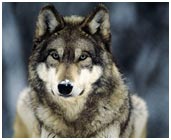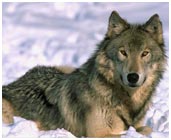Wolf is a mammal, belonging to Canidae family and found almost all across the globe. To get some interesting facts and amazing information on wolves, browse through this article.
Facts About Wolf
Wolf is one of the most feared animals, as far as human beings are considered. It is the largest wild member of the Canidae family and is found inhabiting almost every country in the world, except the continent of Antarctica and some islands. As per the fossil records, wolf is an ice age survivor that originated during the Late Pleistocene, around 300,000 years ago. It shares a common ancestry with the domestic dog (Canis lupus familiaris) and has been suspected by many, to be its ancestor. Once found in abundance, the population of wolves has decreased to quite an extent, mainly because of loss of habitat, high mortality rates and excessive hunting by humans. To know more about this animal, check out the interesting facts and amazing information provided below. 

Facts about Wolf
Binomial Name: Canis lupus
Kingdom: Animalia
Phylum: Chordata
Class: Mammalia
Order: Carnivora
Family: Canidae
Genus: Canis
Species: C. lupus
Height: 0.60 to 0.95 m (26 to 38 inches)
Length (including tail): 1.3 to 2 m (4.5 to 6.5 feet)
Weight: 20 to 62 kg
Number of Teeth: 42
Colors: Gray, tan and brown to pure white or black
Smallest Species: Arabian Wolf subspecies
Chasing Speed: Up to 65 km/h (40 mph)
Diet: Deer, moose, caribou, elk, bison, musk-oxen and beaver
Age: 6 to 8 years (in wild), 12 to 16 years (in captivity)
Age of Maturity: 2 to 3 years
Gestation Period: 60 to 63 days
Number of Offspring: 4 to 6
Interesting & Amazing Information on Wolves
- A mated wolf pair usually stays committed for life. Only when one of them dies, does the other look for another mate.
- A wolf is opportunistic and will always attempt to catch the easiest and most vulnerable animal.
- Wolves actually have a low hunting success rate.
- A wolf's sense of smell is more than 100 times greater than that of a human.
- Wolves usually mate during the months of January to April; the higher the latitude, the later the mating time.
- All members of a wolf pack take part in caring for the young ones.
- It is common for wolves to be on move eight to ten hours in a day and a pack may cover distances from 30 to 125 miles in a day.
- The coyote is believed to have evolved from the wolf, over 500,000 years ago.
- Wolves have two types of 'fur coat'. The undercoat (closest to the skin) is soft and keeps the wolf warm, while the overcoat is made up of long hair and acts as a weather barrier.
- Wolves shed their hair in the spring and summer season. However, they shed it out in sheets, unlike most dogs.
- The highest ranking member in a wolf is ‘Alpha wolf’, the second ranking one is ‘Beta wolf’, while the one with the lowest rank is called ‘Omega wolf’.
- There are two hierarchies in a wolf pack, a group of wolves, one for females and one for males.
- The jaws of a wolf are extremely powerful and are capable of generating 1,500 psi pressure.
- The mortality rate in case of wolf puppies can be as high as 50 percent.
- The wolf has one of the widest ranges of size, shape and color of any mammal in North America.
- Wolves communicate with each other more by harmony and integration, rather than aggression and submission.
- Wolf is generally a docile animal, with a strong aversion to fighting and aggression.
- Wolves are territorial and use vocalizations and scent marking to defend their territory.
- Wolves communicate through a number of ways, including scent marks, vocalizations, visual displays, facial and body postures and rituals.
- Wolves howl to greet each other, indicate their location, define their territory or call the pack together.
- Lone wolves have no social territory and rarely scent-mark or howl.


See also
More from iloveindia.com
- Home Remedies | Ayurveda | Vastu | Yoga | Feng Shui | Tattoos | Fitness | Garden | Nutrition | Parenting | Bikes | Cars | Baby Care | Indian Weddings | Festivals | Party ideas | Horoscope 2015 | Pets | Finance | Figures of Speech | Hotels in India : Delhi | Hyderabad | Chennai | Mumbai | Kolkata | Bangalore | Ahmedabad | Jaipur
- Contact Us Careers Disclaimer Privacy Policy Advertise With Us Lifestyle Sitemap Copyright iloveindia.com. All Rights Reserved.





